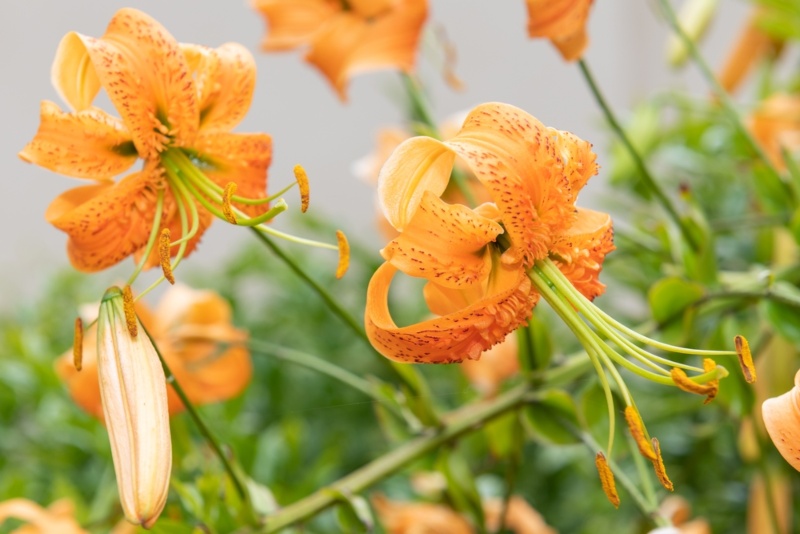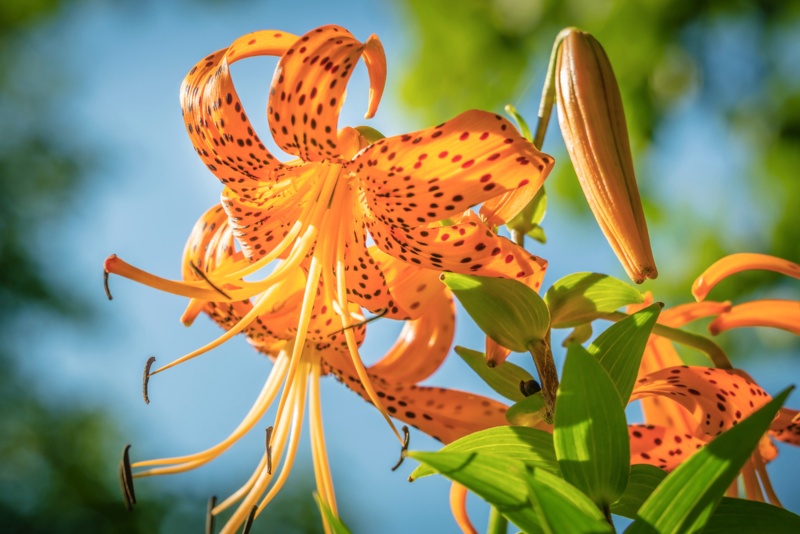Tiger Lilies (Lilium tigrinum) are showy, perennial flowers that can be found in gardens across the United States. These flowers are easy to grow and bloom in late summer or early fall.
Tiger lilies prefer full sun and well-drained soil. They are typically orange with purple dots, but can be yellow, white, and red.

Tiger lilies enjoy sunny locations, so make sure to place them in an area that gets plenty of sunlight. You should also gather some organic compost, potting soil and plant fertilizer to help your Tiger Lilies grow. Organic compost is necessary for the growth and blooming of tiger lilies. It helps to improve the soil texture, water retention capacity, and organic matter content.
Additionally, organic compost aids in the suppression of plant diseases and pests.
| Botanical Name: | Lilium lancifolium |
| Common Name(s): | Tiger Lily |
| Plant Type: | Herbaceous Perennia |
| Mature Size: | 2-5 feet tall |
| Sun Exposure: | Full sun, about 6-8 hours a day |
| Water Needs: | Needs Water Weekly, but matured plants every other week |
| Soil Type: | Moderately Fertile Soil |
| Soil pH: | 5.5 to 6.5 (slightly acidic) |
| Bloom Time: | Summer |
| Maintenance: | Low (once bulbs are planted) |
| Flower Color: | Orange with black spots, but they also can be yellow, white, and red |
| Hardiness Zones: | 3-9 |
| Toxicity: | Toxic to pets, especially to cats |
Light
Tiger Lilies need full sun exposure, this means 6-8 hours of sunlight.
Water
Be sure to water your tiger lilies regularly, especially during times of drought. Though Tiger Lilies don’t need to be watered daily, they do need to be deeply watered at least once a week. If they begin to wilt, they need to be deeply watered more than once a week.
Temperature and Humidity
The best temperature and humidity for tiger lilies to grow in is between 65°F and 75°F, with humidity levels between 50-70%. Nighttime temperatures below 50°F (10°C) prevents blooming and flower development; days above 90°F (32°C) will cause the flowers to wilt and die.

Soil
Because of the bulbs, the soil can’t be soggy, if it is soggy the bulbs will rot. It is important to amend the soil, you do this by adding humus or compost.
Fertilize
A balanced fertilizer at the beginning of spring before planting will give your Tiger Lily a head start. They don’t need much care when it comes to fertilizer, but they do need a base of compost one or two times a year. To encourage growth it is recommended to do a layer of mulch at the beginning of summer or late spring.
Potting and Repotting Tiger Lilies
When planting tiger lilies, make sure to dig a hole that is twice as wide as the pot the plant is currently in. The tiger lily plant has a large root system and during the winter, it will produce thick stalks that can cut through the soil and break through the pot. The best thing to do is leave about two inches of space at the top of your planting container whenever you’re planting new tiger lilies so they don’t grow roots out of control. Or, even better than one hole, make multiple holes around the side of your pot to offer support for these deep roots so they stay in place well.
You should also gather some organic compost, potting soil, and plant fertilizer to help your Tiger Lilies grow. It is recommended to transplant Tiger Lilies in the fall. Transplanting in fall allows them to adjust to the new fertilizer throughout the winter.

Propagating Tiger Lilies
Tiger lilies are a popular flower to grow, but they can be hard to propagate. Choose a good location for the new plant and dig a hole about 8 inches deep, to begin the propagating process.
Fill the bottom of the hole with rocks or gravel so water drains out easily. Add potting soil and plant the old tiger lily.
Be sure to leave about 4 inches of stem above ground level. Water it well and place the pot in a sunny location.
The next year, cut off all but 2 to 3 leaves on top of the plant (leaving 2 to 3 is necessary to keep energy flowing from the roots into the leaves).
In late summer or early fall, you can cut off all but 2-3 of those leaves as well. This will encourage energy to build up in the roots.
It might stop blooming for a year or two, but after that, it should make lots of new blossoms!
Are Tiger Lilies Toxic?
Most parts of Tiger Lilies are not toxic to humans and can be safely ingested.
But they are toxic to cats. If a cat even nibbles on a leaf, or pollen gets on its fur it can be extremely deadly.




